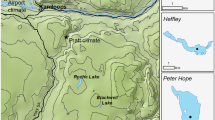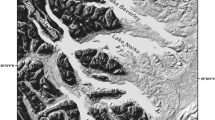Synopsis
Several years ago, we used a bioenergetics model to evaluate the impact of increasing salmonid stocking on the highly variable alewife forage base in Lake Michigan. At that time, we forecast an alewife population decline and the following system-wide effects: increased abundances of large zooplankton, decreased salmonid growth rates, increased diet breadth of salmonids, niche shifts among competitors of the alewife, increased alewife growth rates and increased densities of fishes suppressed by alewife. Alewives have continued to decline steadily since 1981 and are now reduced to a density similar to early outbreak levels in the early 1960s. Recent reports on fish growth rates, zooplankton size and fish community structure support our projections regarding system-wide responses to the alewife decline.
Access this chapter
Tax calculation will be finalised at checkout
Purchases are for personal use only
Preview
Unable to display preview. Download preview PDF.
Similar content being viewed by others
References cited
Anonymous. 1984. Annual Report Great Lakes Fishery Commission, 1982. Ann Arbor. 153 pp.
Christie, W.J. 1974. Changes in fish species composition of the Great Lakes. J. Fish. Res. Board Can. 31: 827–854.
Colby, P.J. (ed.) 1977. Proceedings of the 1976 Percid International Symposium (PERCIS). J. Fish. Res. Board Can. 34: 1447–1999.
Crowder, L.B. 1980. Alewife, rainbow smelt and native fishes in Lake Michigan: competition or predation? Env. Biol. Fish. 5: 225–233.
Eck, G.W. & L. Wells. 1983. Biology, population structure, and estimated forage requirements of lake trout in Lake Michigan. U.S. Fish and Wildlife Serv. Techn. Rep. 111. 18 pp.
Eck, G.W. & E.H. Brown Jr. 1985. Lake Michigan’s capacity to support lake trout (Salvelinus namaycush) and other salmonines: an estimate based on the status of prey populations in the 1970’s. Can. J. Fish. Aquat. Sci. 42: 449–454.
Evans, M., B.E. Hawkins & D.W. Sell. 1980. Seasonal features of zooplankton assemblages in the nearshore of southeastern Lake Michigan. J. Great Lakes Res. 6: 275–289.
Gitter, M.J. 1982. Thermal distribution and community structure of Lake Michigan zooplankton with emphasis on interactions with young-of-year fishes. M.S. Thesis, University of Wisconsin, Madison. 129 pp.
Hagar, J.M. 1984. Diets of Lake Michigan salmonids: an assessment of the dynamics of predator-prey interaction. M.S. Thesis, University of Wisconsin, Madison. 97 pp.
Hatch, R.W., P.M. Haack & E.H. Brown, Jr. 1981. Estimation of alewife biomass in Lake Michigan, 1967–1978. Tran. Amer. Fish. Soc. 110: 575–584.
Kitchell, J.F. 1983. Energetics. pp. 312–338. In: P.W. Webb and D. Weihs (ed.) Fish Biomechanics, Praeger Publ., New York.
Lawrie, A.H. 1970. The sea lamprey in the Great Lakes. Tran. Amer. Fish. Soc. 99: 766–775.
Loftus, K.H. & H.A. Regier (ed.)1972. Proceedings of the 1971 symposium on salmonid communities in oligotrophic lakes (SCOL). J. Fish. Res. Board Can. 29: 611–986.
Rice, J.A. & P.A. Cochran. 1984. Independent evaluation of a bioenergetics model for largemouth bass. Ecol. 65: 732–739.
Scavia, D., G.L. Fahnenstiel, M.S. Evans, D. Jude & J.T. Lehman. 1986. Influence of salmonine predation and weather on long-term water quality trends in Lake Michigan. Can. J. Fish. Aquat. Sci. 43 (in press).
Smith, B.R. (ed.) 1980. Proceedings of the 1979 Sea Lamprey International Symposium (SLIS). Can. J. Fish. Aquat. Sci. 37: 1585–2214.
Smith, B.R. & J.J. Tibbles. 1980. Sea lamprey (Petromyzon marinus) in lakes Huron, Michigan, and Superior: history of invasion and control, 1936–1978. Can. J. Fish. Aquat. Sci. 37: 1780–1801.
Smith, S.H. 1968. Species succession and fishery exploitation in the Great Lakes. J. Fish. Res. Board Can. 25: 667–693.
Smith, S.H. 1970. Species interactions of the alewife in the Great Lakes. Trans. Amer. Fish. Soc. 99: 754–765. Spangler, G.R., A.H. Berst and J.F. Koonce. 1981. Perspective and policy recommendations on the relevance of the stock concept to fishery m,anagement. Can. J. Fish. Aquat. Sci. 38: 1908–1914.
Stewart, D.J. 1980. Salmonid predators and their forage base in Lake Michigan: a bioenergetics modeling synthesis. Ph.D. Thesis, University of Wisconsin, Madison. 225 pp.
Stewart, D.J., J.F. Kitchell & L.B. Crowder. 1981. Forage fishes and their salmonid predators in Lake Michigan. Trans. Amer. Fish. Soc. 110: 751–763.
Stewart. U.J., D. Weininger, D.V. Rothers and T.A. Edsall. 1983. An energetics model for lake trout, Salvelinus namaycush: application to the Lake Michigan population. Can. J. Fish. Aquat. Sci. 40: 681–698.
Talhelm, D.R., R.C. Bishop, K.W. Cox, N.W. Smith, D.N. Steinnes & A.L.W. Tuomi. 1979. Current estimates of Great Lakes fisheries values: 1979 status report. Great Lakes Fishery Commission. Ann Arbor. 79–1: 17 pp. (mimeo)
Ursin, E. 1982. Stability and variability in the marine ecosystem. Dana 2: 51–67.
Walters, C.J., G. Spangler, W.J. Christie, P.J. Manion & J.F. Kitchell. 1980. A synthesis of the knowns, unknowns, and policy recommendations from the Sea Lamprey International symposium. Can. J. Fish. Aquat. Sci. 37: 2202–2208.
Wells, L. & A.L. McLain. 1973. Lake Michigan: man’s effect on native fish stocks and other biota. Great Lakes Fish. Comm. Tech. Rep. 20. 55 pp.
Wells, L. & R.W. Hatch. 1985. Status of bloater chubs, alewives, smelt, slimy sculpins and yellow perch in Lake Michigan, 1984. Mimeo report to the Great Lakes Fishery Commission, Lake Michigan Committee, March 19, 1985.
Author information
Authors and Affiliations
Editor information
Rights and permissions
Copyright information
© 1986 Springer Science+Business Media Dordrecht
About this chapter
Cite this chapter
Kitchell, J.F., Crowder, L.B. (1986). Predator-prey interactions in Lake Michigan: model predictions and recent dynamics. In: Simenstad, C.A., Cailliet, G.M. (eds) Contemporary studies on fish feeding: the proceedings of GUTSHOP ’84. Developments in environmental biology of fishes, vol 7. Springer, Dordrecht. https://doi.org/10.1007/978-94-017-1158-6_17
Download citation
DOI: https://doi.org/10.1007/978-94-017-1158-6_17
Publisher Name: Springer, Dordrecht
Print ISBN: 978-90-481-8518-4
Online ISBN: 978-94-017-1158-6
eBook Packages: Springer Book Archive




